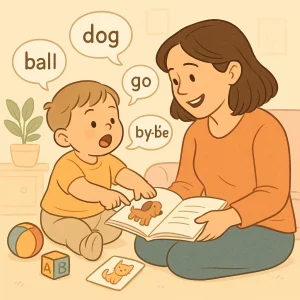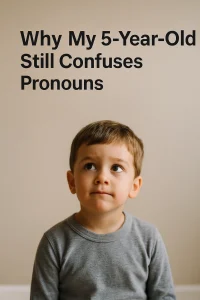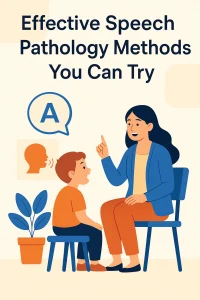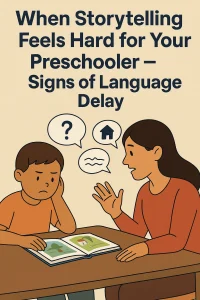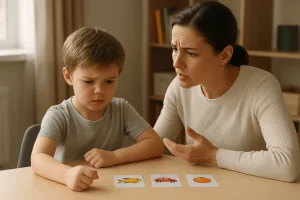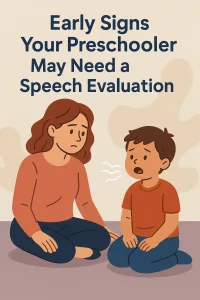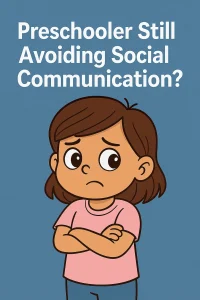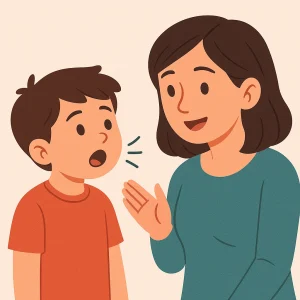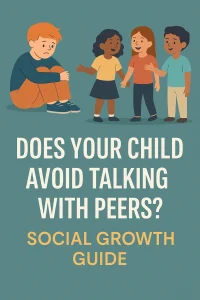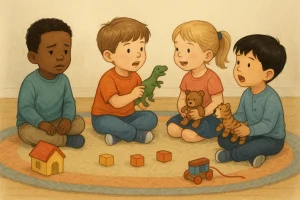Help Your Child Master the /r/ Sound (Easy Tips!)
By Rajini D
Last Updated: March 20, 2024
Welcome to a journey where we unravel the mysteries of the /r/ sound, a pivotal element in clear and confident communication. Imagine the /r/ sound as a chameleon, versatile yet complex, blending into various linguistic landscapes with ease. Its mastery is a cornerstone for expressing thoughts, emotions, and needs effectively, making its learning not just an academic exercise but a bridge to the world.
Yet, this journey isn’t without its twists and turns. Many parents find themselves navigating through a maze, puzzled by their child’s struggles with this elusive sound. Its cloak of invisibility poses a unique challenge: it’s heard loud and clear but tricky to teach and learn due to its hidden articulation. Children often grapple with shaping their tongues just right to produce the vibrant /r/, sometimes substituting it with a /w/ or a distorted ah sound, making “rabbit” sound like “wabbit” and “car” like “cah.”
Understanding the /r/ Sound
Why Is the /r/ Sound Tricky?
Imagine trying to catch a fish with your bare hands in a clear, moving stream. You can see it; you know what you need to do, but the fish’s swift, slippery nature makes it a challenge to grasp. This is what children face with the /r/ sound. It’s not just a single sound but a collection of sounds, each with its own unique tongue placement and vocal expression. From the robust /r/ in “rabbit” to the softer one in “car” and the complex blend in “forest,” the /r/ sound wears many disguises.
The main trickster here is how the /r/ sound is produced. Unlike more visible sounds, where you can easily mimic the lip movements, the /r/ sound is a covert operation happening inside the mouth. The tongue twists and turns in a precise dance that is hard to see or describe, making it a hidden mystery for the eager but perplexed child trying to decode the secrets of speech.
Also read: Speech Sound Disorders: Causes, Treatment and Strategies
When Should Your Child Master the /r/ Sound?
Every child’s journey through the landscapes of language is unique, painted with their own pace and hues of learning. While the /r/ sound may start to appear in a child’s verbal repertoire around the age of three, it’s not uncommon for this sound to fully bloom closer to six or even seven years of age.
It’s important to remember that speech development is not a race but a journey of discovery and growth. By the age of five or six, most children will be experimenting with various /r/ sounds, refining their technique as they go. However, it’s perfectly normal for some children to take a little longer to find their rhythm with the /r/ sound.
Read more: Is My 3-4 Year Old Talking Enough? A Parent’s Guide to Milestones
Typical /r/ Sound Development Milestones
| Age Range | Developmental Milestone | Tips |
|---|---|---|
| 2-3 Years | Begins to attempt /r/ sounds | Encourage imitation of simple /r/ sounds. Use animal noises and car engines as playful examples. |
| 3-4 Years | Improves clarity of /r/ sounds in words | Practice /r/ sound at the beginning of words with fun activities and games. |
| 4-5 Years | More accurate /r/ sound in words | Introduce /r/ sound in different word positions (start, middle, end) with storytelling and reading aloud. |
| 5-6 Years | Uses /r/ sound correctly in sentences | Engage in conversations that encourage the use of /r/ words; provide gentle corrections. |
| 6+ Years | Masters /r/ sound, including complex /r/ variations | Reinforce correct usage with challenging words and phrases; praise progress. |
Know more: Top R Words Speech Therapy Activities for Kids
Teaching Techniques for the /r/ Sound
Visual and Tactile Cues to Encourage Correct Tongue Placement
The art of mastering the /r/ sound often starts with understanding where and how the tongue should move. Here are two simple yet effective ways to guide your child:
- Mirror Magic: Grab a mirror and encourage your child to play detective, observing their tongue’s movements as they attempt the /r/ sound. This visual feedback is invaluable and turns practice into a fun game. Challenge them to notice how their tongue curls up or stretches, transforming abstract instructions into something they can see and mimic.
- Tongue Depressor Trails: Use a tongue depressor to gently guide your child’s tongue to the correct position. Coupled with your instructions, this tactile cue helps them ‘feel’ where their tongue should be, making the invisible visible. For a touch of whimsy, describe it as a “magic wand” guiding their tongue to discover treasure – the perfect /r/ sound.
Learn more: 12 Activities to Boost Kids Speech & Language
Fun with Sounds: From Animals to Engines
Inject a dose of fun into speech practice with imaginative play. Here’s how you can make the /r/ sound come alive:
- Roaring Lions and Racing Cars: Encourage your child to imitate the majestic roar of a lion or the thrilling rumble of a race car. These playful scenarios not only make practice sessions enjoyable but also naturally guide the production of the /r/ sound. Each roar and rumble is a step closer to clarity.
- The Pirate’s ‘Arrr’: Dive into the world of pirates and treasure hunts, where the ‘Arrr’ sound reigns supreme. This not only captures your child’s imagination but also provides ample practice of the /r/ sound in a fun, engaging context.
Integrating the /r/ Sound into Daily Activities
Learning doesn’t have to be confined to specific practice times. Here are simple ways to incorporate the /r/ sound practice into everyday life:
- Storytime Adventures: Pick books with characters or themes that emphasize the /r/ sound. Emphasize and exaggerate the sound as you read together, making storytime both educational and entertaining.
- Daily Dialogues: Throughout the day, find opportunities to emphasize words with the /r/ sound in your normal conversation. It could be during meals, playtime, or while running errands. “Look at the red car!” or “Shall we read a book?” This subtle reinforcement helps them hear and practice the sound in a natural setting.
Advanced Strategies
Progressing from Sounds to Words and Beyond
The journey from mastering a sound in isolation to using it fluently within language is akin to learning to play a note on a piano and then using it to perform a symphony. Here’s a step-by-step guide to facilitate this transition:
- Isolation to Syllables: Once your child can confidently produce the /r/ sound on its own, blend it with vowels to form syllables, such as “ra, re, ri, ro, ru.” Celebrate each small victory, turning practice sessions into a symphony of success.
- Syllables to Words: Next, introduce words that begin with the /r/ sound, like “run” and “rabbit,” followed by words where /r/ appears in the middle or at the end, such as “carry” and “star.” Use visual aids and objects to make this more engaging.
- Words to Phrases: Begin to string words together into short phrases, like “red rose” or “run fast.” This not only helps with the /r/ sound but also nurtures a sense of sentence structure.
- Phrases to Sentences: Encourage your child to create sentences with /r/ words. For instance, “The rabbit runs fast.” This step merges their understanding of the /r/ sound with their growing language skills.
- Sentences to Conversation: The final stage is integrating the /r/ sound into spontaneous conversation. This might take time, but with gentle reminders and practice, your child will start using their newly mastered sound naturally.
Explore more: Articulation Disorder: A Comprehensive Guide to Clear Speech
Tailored Techniques for Different Types of /r/ Sounds
The /r/ sound is a chameleon, changing its form in prevocalic (before a vowel) and vocalic (after a vowel) positions and blending into various sound combinations. Here’s how to approach these variations:
- Prevocalic /r/: Begin with words where /r/ precedes the vowel, like “run” or “read.” These are often more straightforward for children to grasp.
- Vocalic /r/: Introduce words with /r/ following vowels, which can be more challenging. Use words like “car,” “hear,” and “door.” Break them down into smaller parts, focusing on the vowel sound before adding the /r/.
- R Blends: When /r/ combines with another consonant at the beginning of words, such as “br” in “bread” or “cr” in “crab,” practice them as separate sounds first, then blend them together slowly.
Overcoming Common Hurdles
For Parents and Caregivers:
- Patience Testing: The journey to /r/ sound mastery can test your patience. Remember, progress in speech development, like in nature, follows its own rhythm. Celebrate small victories and remember that each child’s journey is unique.
- Consistency: Finding the time and energy for regular practice can be daunting. Incorporate practice into daily routines, like during meal times or on the drive to school, to make it part of your natural conversation rather than an added task.
- Doubt: It’s normal to wonder if you’re doing enough or doing it right. Reach out to communities, join forums, or consult with professionals to reinforce your efforts with knowledge and support.
For Children:
- Frustration: When children struggle to produce the /r/ sound correctly, they may feel frustrated or embarrassed. Use games and activities to make practice fun, reducing stress and increasing motivation.
- Boredom: Repetition is key to mastering speech sounds, but it can be boring. Spice up practice sessions with varied activities, apps, or challenges to keep things interesting.
- Confidence: Difficulty with speech sounds can impact a child’s confidence, especially among peers. Celebrate all efforts, regardless of the outcome, to build their self-esteem and encourage perseverance.
Common /r/ Sound Errors and Corrections
| Common Error | Correct Form | Practice Tip |
|---|---|---|
| W for R (wabbit for rabbit) | Rabbit | Emphasize the tip of the tongue curling up towards the roof of the mouth. |
| Ah for R (cah for car) | Car | Practice with words where the R follows a clear, strong vowel sound to help with positioning. |
| L for R (lun for run) | Run | Focus on the difference between the L and R sounds by practicing in front of a mirror to see the tongue’s position. |
| Omitting R (paper for paper) | Paper | Work on ending sounds by slowly pronouncing words in segments and emphasizing the R sound at the end. |
Also Read: Early Identification/ Warning Signs in child development.
When to Seek Professional Help
While many children successfully navigate the complexities of the /r/ sound with the help of parents, caregivers, and educators, there are times when professional assistance can make a significant difference. Here are signs that suggest it might be time to consult a speech-language pathologist (SLP):
- Age Considerations: If your child is significantly older than the typical age range for /r/ sound mastery (usually around 6-7 years) and continues to struggle, professional guidance can offer targeted support.
- Frustration and Avoidance: When a child’s difficulty with the /r/ sound leads to avoidance of speaking or visible distress, it’s crucial to seek help to address these challenges in a supportive, therapeutic setting.
- Impact on Communication: If the speech sound difficulty is affecting your child’s ability to communicate effectively, be understood by others, or is impacting their academic performance, an SLP can provide strategies and interventions tailored to their needs.
- Other Speech or Language Concerns: If the /r/ sound issue is part of broader speech or language difficulties, a comprehensive evaluation by an SLP can identify underlying issues and create a holistic plan for support.
At Wellness Hub, we understand that each child’s path to clear and confident communication is unique. Our resources, guidance, and professional network are here to support you and your child every step of the way. Remember, seeking professional help is a sign of strength and commitment to your child’s development. Together, with the right support, every child can overcome hurdles and achieve their communication goals.
Conclusion
As we wrap up our exploration of mastering the /r/ sound, it’s clear that patience, practice, and positivity are key. This journey, unique to every child, is paved with challenges but also rich with opportunities for growth and connection. Through engaging techniques, imaginative play, and integrating learning into daily life, we’ve outlined a path that fosters both confidence and skill in communication.
Wellness Hub is here to support you every step of the way. Our resources and expert advice are tailored to promote children’s development and wellness, offering a guiding light for parents navigating this journey. We invite you to explore further with us as we continue to provide support and celebrate each milestone alongside you and your child.
Frequently Asked Questions:
1. Why is the /r/ sound so difficult for children to learn?
The /r/ sound is challenging for many children due to its unique production requirements. Unlike most other sounds, the /r/ sound involves complex tongue movements that are not easily visible, making it harder for children to mimic. Additionally, there are multiple variations of the /r/ sound (such as prevocalic /r/, vocalic /r/, and /r/ blends), each requiring different tongue placements.
2. At what age should children be able to pronounce the /r/ sound correctly?
Children typically begin to develop the ability to pronounce the /r/ sound around the age of three, with most mastering it by the age of six or seven. However, it’s not uncommon for some children to take a bit longer. Consistent practice and encouragement can support their progress.
3. How can parents help their child practice the /r/ sound at home?
Parents can help by engaging in activities that make practice enjoyable and part of daily routines. Using mirrors for visual feedback, playing sound imitation games, and incorporating the /r/ sound into storytelling or everyday conversations are effective strategies. Encouragement and positive reinforcement go a long way in keeping children motivated.
4. What are some common mistakes children make when learning the /r/ sound?
Common mistakes include substituting the /r/ sound with a /w/ sound (e.g., saying “wabbit” instead of “rabbit”) or omitting the altogether. Some children may also struggle with the correct tongue placement, leading to variations in the sound’s production.
5. How can teachers support students struggling with the /r/ sound?
Teachers can support students by providing additional practice opportunities, offering gentle corrections, and incorporating speech-sound activities into classroom routines. Collaboration with speech-language pathologists for targeted interventions may also be beneficial for students facing more significant challenges.
6. Are there any tools or resources recommended for practicing the /r/ sound?
Yes, there are several resources available, including speech therapy apps, websites with phonetic exercises, and educational games focused on speech sounds. Books and visual aids that highlight the /r/ sound can also be useful. Consulting with a speech-language pathologist can provide personalized recommendations based on the child’s needs.
7. When should parents consider seeking help from a speech therapist?
Parents might consider seeking help if their child is significantly behind the typical age range for /r/ sound mastery without showing signs of progress, exhibits frustration or avoidance behaviors related to the sound, or if there are broader concerns about speech and language development. A speech therapist can offer targeted strategies and support to address these challenges.
8. How can I make learning the /r/ sound fun for my child?
Making learning fun is crucial for children, especially when tackling something as tricky. Transform practice sessions into games or imaginative play. For example, pretend to be pirates searching for treasure, emphasizing the ‘Arrr’ sound, or turn into animals that ‘roar’ to practice the sound. Apps and online games focused on speech development can also add variety and fun to learning, keeping your child engaged and motivated.
9. What are the signs my child might need help from a speech therapist?
It’s normal for children to face some challenges while learning speech sounds, but there are signs that may indicate the need for professional help. If your child is significantly older than the typical age range for sound mastery (usually around 6-7 years) and still struggles, avoids using /r/ words due to difficulty or frustration, or if speech issues impact their confidence or ability to communicate clearly, consulting a speech-language pathologist could be beneficial.
10. Can learning the /r/ sound impact my child’s academic performance?
Yes, mastering speech sounds, including the /r/ sound, can have a significant impact on academic performance. Clear speech is crucial for effective communication, reading, and writing skills. Difficulties with the sound can sometimes lead to challenges with spelling, reading comprehension, and participation in classroom discussions. Early intervention and support in mastering speech sounds can enhance your child’s confidence and performance in academic settings.
About the Author:
Rajini Darugupally
M.Sc., Speech-Language Pathologist (9+ years of experience)
Rajini is a passionate and dedicated Speech-Language Pathologist with over 9+ years of experience, specializing in both developmental speech and language disorders in children and rehabilitation in adults. Driven by a desire to empower each individual to find their voice, Rajini brings a wealth of experience and a warm, genuine approach to therapy.
Currently, at Wellness Hub, she thrives in a team environment that values innovation, compassion, and achieving results for their clients.
Connect with Rajini to learn more about how she can help you or your loved one find their voice.
Book your Free Consultation Today
Parent/Caregiver Info:
Client’s Details:
* Error Message
